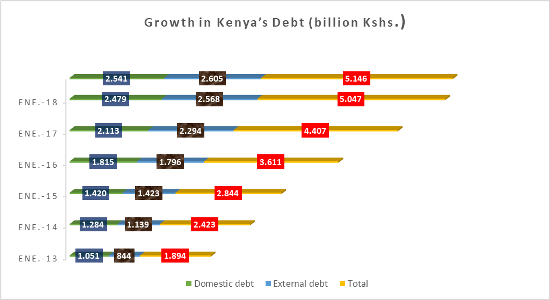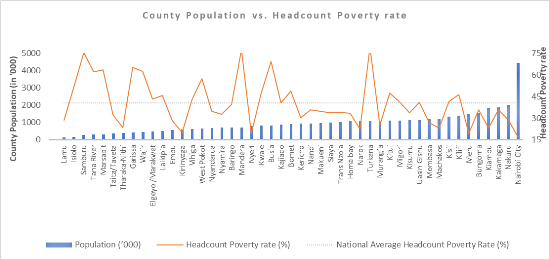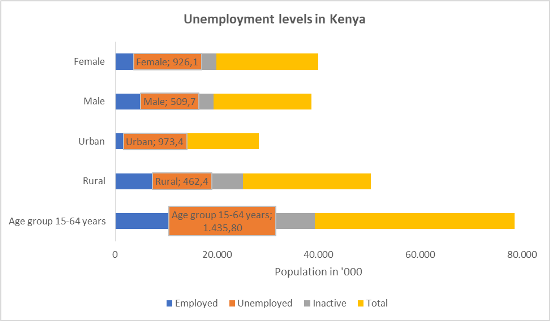Devolution: A curse of a panacea for addressing inequality in Kenya
Edward Oyugi
Social Development Network (SODNET)
Introduction
The Kenyan society, like any other class-societies in the world is in crisis. The crisis is not only social. It is also economic and political. Debt burden is piling as runaway corruption threatens to reverse the gains so far made in addressing the challenges of Sustainable Development Goals. To be sure, the many crises the country is facing feed into each other and occasionally conflate into unmanageable political-economic conditions. Obviously, none of the crises, including the rapidly encroaching threat of ecological disaster, can be overcome without dealing a deadly blow to and, if possible, reversing the growing inequalities and drastically altering the way the nation’s economic system operates. A ballooning precariat, a dwindling middle class and a shrinking economy - arising from a shrinking national income and increasing job-creation challenges undermine the prospects of realizing the SDGs.
Post-colonial Kenya has been a fertile experimental scene for a wide variety of development policies marked, strangely, by their remarkable consistency in the manner in which they have successively promoted inequality and social exclusion of varying kinds of severity. In the process, a wide range of home-grown policy efforts have been directed at addressing its deleterious effects on social cohesion and stability. These include but are not limited to The Sessional Paper No.10 of 1965, Special Rural Development Program (SRDP) of 1971, Sessional Paper No. 4 of on economic prospects Policies of 1975, The District Focus for Rural Development (DFRD) 1983, Constituency Development Fund, Local Authorities Transfer Fund (LATF) and Vision 2030.
Their ideological and strategic limitations in addressing inequality in general and exclusion in particular have been a subject of concerted critical appraisal, touching on their inability to address the underlying systemic causes and historical origins of inequality; save to add that the critiques, apart from recognizing certain gains so far chalked up, did yield mixed results. With devolution of governance structures, expressly provided in the 2010 constitution, being compromised by the widespread fear that a running theme of downward replication of inequality is under way and gaining morbid traction at the sub-national national levels, the hope for a sustainable society may linger on (in various forms) and, for that matter, render sustainability as an empty signifier if not maintain such hope on a life-support by an elite determined to keep the flames of a hegemonic world view running out of viability. The fear has gained in morbid reality, as corruption and rent-seeking behaviors at the county levels have exceeded even the most generous presentiments. To be sure, the main challenge the devolved sub-national entities faced both singly and collectively ranged from unyielding and up to some point, closet re-centralizing tendencies, corruption, lack of political will in favor of decentralization with an in-built agenda for inclusivity and bureaucratic resistance against decentralization of power by the lingering despotic tendencies of the past. The counterproductive outcomes of the combined effects of the above policy interventions have exposed, beyond a scintilla of doubt, class-society’s dubious advances and illusions of progress in the great arrow of human history and progress under capitalism and other hegemonic civilizations of the distant and recent past.
Constitutional Economics of Devolution
The 2010 constitution, haggled out in a fierce contest between a rightwing government of President Moi and a coterie of liberal opposition political actors and civil society formations, provided for DEVOLUTION as a policy instrument, broadly and vaguely intended to rein in runaway marginalization and social exclusion of different sections of the Kenyan society on the basis of such factors as: ethnicity, region, gender, generation, urban versus rural and, of course, class and other identitarian formations. To be sure, it has served as the flagship policy framework of Kenya’s commitment to the ideals of SDG. Having assumed the strategic role of a primary policy instrument to address regional and subnational/ethnic inequalities, it has lurched through a critical phase of relative take-of as well strategic retardation of the national economy.
In this regard, more information/data is required beyond rough generalizations and run-of-the-mill certainties, to generate the necessary and relevant insights into greater understanding and critical appreciation of exclusion and marginalization as the centerpiece of the discourse on social justice. This is of paramount importance for the eventual development and horning of strategic efficiency of devolution as a flagship narrative designed not only to tackle extreme poverty but also to be deployed as an open method of coordinating economic and social policies in support of sustainable economic integration and equitable social progress.
Inequality as the defining issue of our time
Inequality is the biggest challenge of our time. It undermines social confidence and reduces operational support for democratic institutions. It lurks behind the new toxic relationship that Western societies have established with their future and explains, to a large extent, much of recent resentment-driven electoral phenomena and the surge of identity politics with its disruptive backlash on the benefits of social stability and equity as a sine qua non for overall sustainability of a good society. As a social policy dysfunction, the intervention program intended to address it have ingenuously reserved a strategic maneuver room in which the nature and understanding of its main causes are not only obscured but more importantly problematized beyond the need to apportion blame upon different actors in society. Using the English language trick widely known as nominalization - whereby strong and transitive verbs are neutered and turned into soft nouns - the phenomenon of inequality and allied social pathologies are not only obscured but rendered apocryphal.
In this case, nominalization tends to produce two linguistic effects. The first is that the important factor of agency disappears, i.e., whoever or whatever was causing the marginalization to happen becomes either abstract or invisible. The second effect is that exclusion and inequality as a social reality is conveniently abstracted from the political-economic context in order to render it a thing in its own right i.e., without cause and effect. Meaning: it just happens, and, therefore nothing can be done about it. The end result is that macro-economic policy failures and political power-relations are thus conveniently removed from the strategic calculus of addressing social exclusion as a structural and systemic problem. As a matter of fact, inequality and exclusion include many internal and external forces, the principal ones of which involve, among other factors:
- The balance of social forces in a given society, providing conditions for hegemonic relations
- The organization and operation of the market – level and manner of concentration and relative distance from the market and its advantageous and disadvantageous operations
- The democratic foundation and practices of the state and its instruments of hegemonic control of society
- The historical mission of the dominant classes/interest of the society in question.
To be sure, it speaks keenly to the broad canvas of human dimensions that have a lot to do with populations and their diverse and conflicting interests, religion, culture and social stratification e.g., caste, ethnicity, gender, geography etc. In the majority of cases it has a lot to do with the inability of a society or a social formation to keep all the groups and individuals - within reach of what is expected of a society - to realize their full potential as sovereign citizens. Such exclusion may be in respect to housing, employment, education, democratic participation, due process and other basic social services, including water, roads etc.. Beyond all this, many other opportunistic vicissitudes can then pray on the initial state of exclusion, discrimination, nepotism sub-national identity crisis and many others.
As has been insinuated above, neo-classical economics trace exclusion and social inequality to individual or group character flows or strengths or cultural resistance to the ethos of modernity and its collective appeal: thus the industrious Kikuyu, the happy-go-lucky Coastals, the pleasure-loving Luo, the culturally backward Maasai are some of the characterizations invoked to justify marginalization. Based on flawed anthropological foundations of European imperial scholarship, these prejudices can no longer be the basis of explaining marginalization of certain sections of the society. Policies addressing social exclusion and inequality should, therefore, no longer ride on the faulty notion of poverty championed by Alfred Marshal as reflecting a state of laziness or being “limp in body and mind” and not a function and operation of ideological choices, systemic and structural conditions. To be sure, we must begin to see in exclusion and inequality a structural phenomenon, endemic in situations of unequal development associated with liberal market societies. We will then see marginalization as systematically built into the workings of liberalized market economies and not accidental to them.
Faces of Inequality
The faces of inequality and exclusion are legion. They give depressing expression to the challenges facing Devolution in a world in which globalization is steadily complicating local agenda for addressing the scourge of inequality. Depending on where we sit in society, they assume different forms: the homeless Kenyan sleeping under the bridges and in the subways of Thika Highway; underfed children from Nyatike - wasting away from diarrhea that could be prevented if only a well-equipped dispensary could be in reach at affordable costs; the struggling nomads from Wajir and Maasai herders from Narok whose animals dehydrate and die as they trek long distances in search for water and pasture. The seemingly wide-net characterization of inequality reminds us that exclusion is not simply one thing or another; in fact, not just one social status. While an absence of economic opportunities and associated amenities may characterize specific aspects of inequality among and or exclusion of certain groups, lack of knowledge, political right, capacity, recognition and power are also factors influencing the incidence of inequality and exclusion. But most important, all the implied transgressions have the same origin: the dominance of an economic paradigm characterized by free-market oriented neo-liberal policies according to which competition is everything and cooperation or solidarity is devoid of the necessary ethical value.
 |
Source: KNBS 2015/16
As has been insinuated above, neo-classical economics trace exclusion and social inequality to individual or group character flows or strengths or cultural resistance to the ethos of modernity and its collective appeal: thus, the industrious Kikuyu, the happy-go-lucky Coastals, the pleasure-loving Luo, the culturally backward Maasai, the obedient Kamba etc. are some of the characterizations invoked to justify marginalization. Based on flawed anthropological foundations of European imperial scholarship, these prejudices can no longer be the basis of explaining marginalization. Policies addressing inequality should no longer ride on the faulty notion of poverty championed by Alfred Marshal as reflecting a state of laziness or being “limp in body and mind” and not a function and operation of ideological choices. We must begin to see in exclusion and inequality a structural and systemic phenomenon, endemic in situations of unequal development associated with liberal market societies in general and colonial societies in particular. We will then see marginalization as systematically built into the workings of liberalized market economies and not accidental to them.
Unsustainable Debt
The national Treasury recently released the 2018 edition of the public debt management report. The report presents interesting reading of national debt statistics; mostly deceptively optimistic. For instance, while the economy is said to be growing by only 4.9 per cent in the 2017/18 fiscal year, relative to 5.9 per cent in 2016/17, public debt is said to have grown by 14.5 per cent during the same period - to stand at Sh5,047 billion. Ostensibly and, in simple terms, the country’s indebtedness is assumed to have grown at a faster rate than its income, which amounts to its intrinsic ability to service debt. In reality this does not speak to the facts on the ground. The report reveals that debt-to-GDP ratio stood at 57.1 per cent during the 2017/18 year, a marginal reduction from the previous 57.5 per cent which does not seem to leave a comfortable margin between the figure in question and the conventionally accepted 60 per cent debt-to-GDP ratio as the rule-of-the-thumb threshold for debt sustainability.
In the medium term, to be sure, the public debt management report indicates that the country’s debt service-to-revenue ratio is more than likely to exceed the 30 per cent threshold and is projected to remain that way in the medium term. The available data, therefore, appears to indicate that the country is erratically wobbling under intense pressure of an unprecedented debt overhang; a sign of the deterioration of the economy as function of excessive public debt and lip-service attention to its successful management. Two reasons partly explain the asymmetry between interest payment and principal retirement. First is the country’s growing use of the more expensive external commercial debt. Since June 2013, the proportion of external commercial debt to total external debt has risen from under two to more than 34 per cent. There is no convincing reason to believe that these downward trends are going to be reversed sustainably in the medium term. Real GDP is forecast to improve only marginally from about 5.9 in 2018 to about 6.1 per cent by 2020.
Growth in Kenya’s debt during the last 5 years
 |
Source: National Treasury Quarterly Economic Reviews, BROP 2018 & CBK 2018 report
Further, data from the Central Bank of Kenya shows that the country is struggling to finance its recurrent expenditure. For the first 11 months of last year, total (tax and non-tax) revenue stood at Sh8.604 trillion against recurrent expenditure of Sh9.116 trillion. This implies that the country borrowed partly to pay interest on debt, which constituted 20.4 per cent of recurrent spending for the period. When an economic agent borrows to service its debt obligations, debt utilization must be seen as unsustainable. Sooner than later, lenders, such as China, whose debts are partly guaranteed by strategic public assets, may exercise their right of lien on those assets as happened elsewhere. In such a situation, one wonders, The Big Four agenda will be financed, but more important, how affirmative expenditures expected to address inequalities and uplift the conditions of the poor will be generated!
Regional and county-based disparities have a long and understandable history in Kenya. Colonialism, with unequal development wired into its systemic character was responsible for the structural origins of regional disparities. It follows that general economic improvement has had to be skewed in favor of regions that were favored by the extractive imperatives of the colonial political economy. And the post-colonial chlorophyll approach to economic development did not help. Instead, it reinforced the colonial patterns of unequal development. The implied variations speak to the following indicators: perception of general direction of the economy, living conditions – income and welfare perceptions, access to basic needs including cash income, access to services.
 |
Source: KNBS Integrated Household Budget Survey report on wellbeing 2015/16
Given that nearly all political issues take a regional or ethnic angle and depending on the nature of the reigning state, produced by such considerations, development will always follow the pattern of the balance of social forces in the Kenyan society. There is, therefore, need to create and enhance institutions that promote equity and inclusive growth as the country develops. The disparities captured by the data below cannot sustain a steady and inclusive growth of a robust national economy.
The shame of unemployment in Kenya
The employment sector is gradually turning out to be the Achilles heels of the Kenyan economy. Though, as a sector, it is one of the key pillars of Uhuru’s Big Four agenda, it remains the main source shame for the national economy. The other pillars are universal healthcare, food security, and low-cost housing. The already poor economy of Kenya has seen many companies shed jobs in the recent past; many of them either folding up, shipping out or simply downsizing – leaving thousands jobless or joining the increasing lot of the precariat.
The situation has been worsening over time but nearly reached a crisis level last year when the economy slowed down due to an extended electioneering period, reduced credit uptake by the private sector, and a crippling drought to boot.
 |
The 2015/16 Kenya Integrated Household Budget Survey showed that even for the many Kenyans who were employed, their skills were not fully being utilized, with graduates increasingly taking jobs that could easily be done by Form Four leavers and the rest joining the growing army of the precariat. The survey indicated that 3.7 million or 20.4 per cent of the employed persons in the working-age population were under-employed, meaning they were available to work for more hours but were not given the opportunity. Those mostly underemployed were aged between 15 and 19 years. Their under-employment rate stood at 55.4 per cent. The data below captures an increasingly unsustainable situation that may turn into a time bomb for a tumultuous future.


